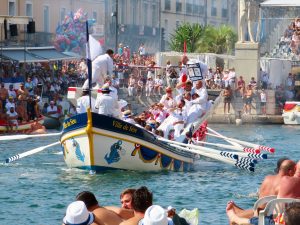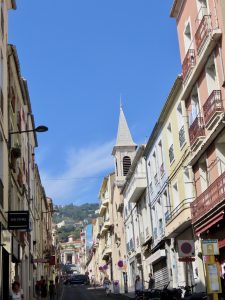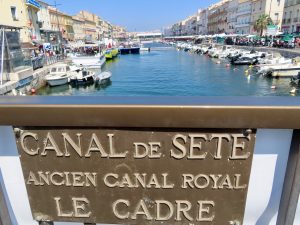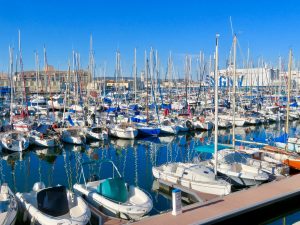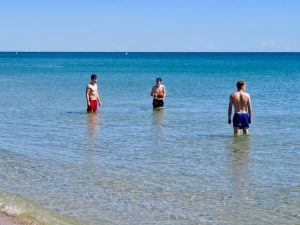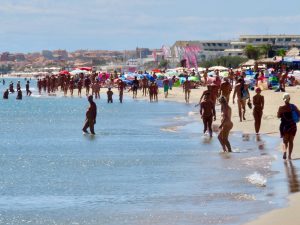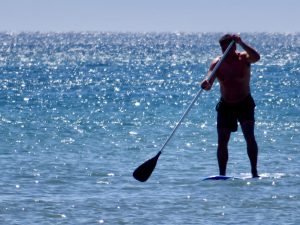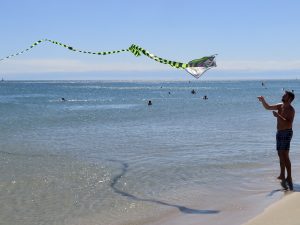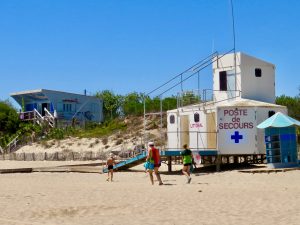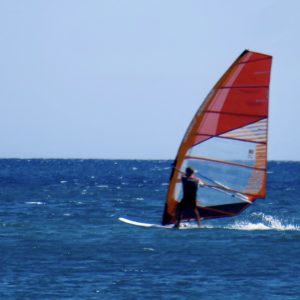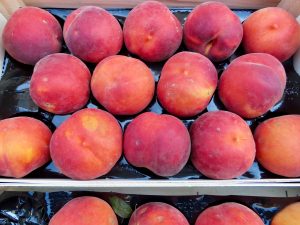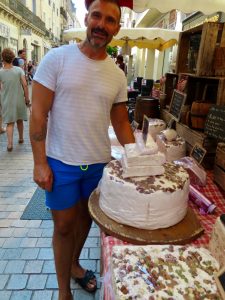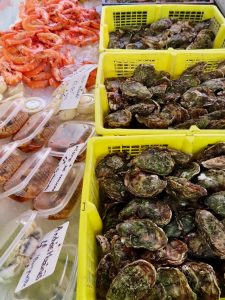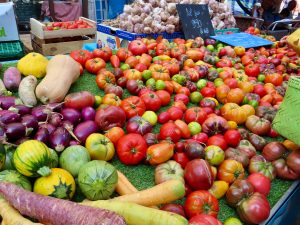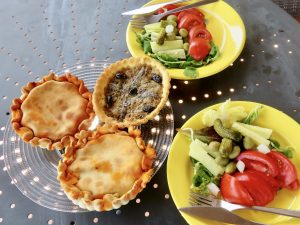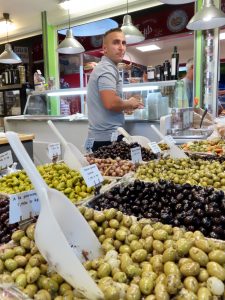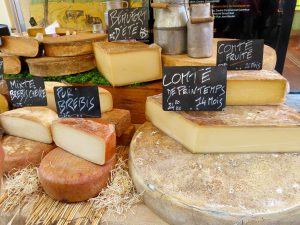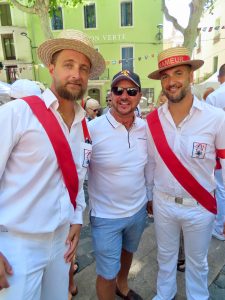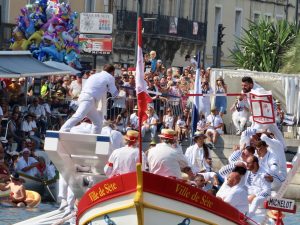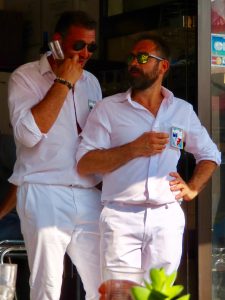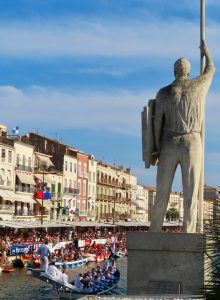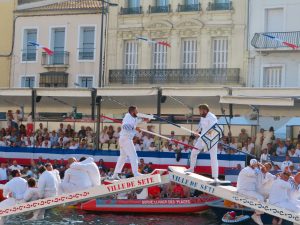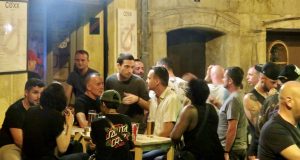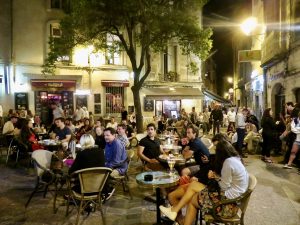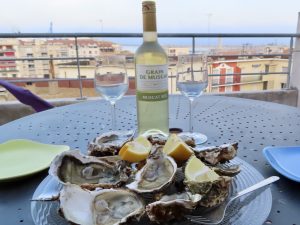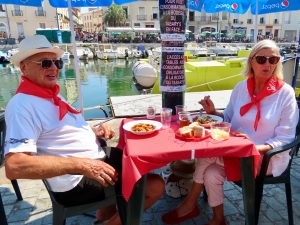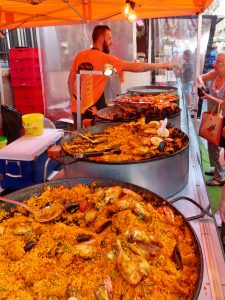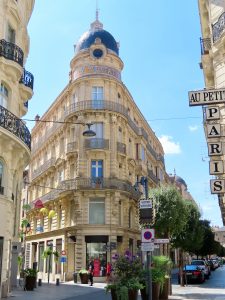We found a new romance in the south of France, right in the heart of the Languedoc Region. Our first impression of the port town of Sète, situated on the Mediterranean coast, was of a rather unremarkable seaside village.
However, during our two week stay, Sète revealed its unspoilt charm and divulged its raw beauty, its casual, relaxed vibe and a deep sense of French culture. Now we repeat our liaison every year.
Sète is slowly making the transition from its historical roots as a working port to a popular tourist destination. Trawler boats still fill the harbour, along with the raw, salty smell of fresh seafood, wet nets and the sad wail of supersized sea gulls. But during the summer months the tourist numbers swell and the town becomes the epicentre of festivities.
Canal de Sète is the ancient waterway that runs right through the heart of the town. Restaurants and bars flank each side of the canal and it is a perfect ringside seat to sample fresh oysters, the local Rosé and traditional French fare while watching the summer sun set over the Mediterranean.
Our days in Sète featured leisurely hours lounging at the nude beach, shopping for stunning, local food and wine, enjoying the many ‘manifestations’ (festivals) and taking the occasional drive to quaint, local towns. Here is a sample of some of the best Sète has to offer.
Nude Gay Beach
A little way south of the port of Sète there are some outstanding wide, wild, sandy beaches. The nude beach is near the famous naturist town of Cap d’Agde, a twenty minute drive from Sète. We park our car in the nearby seaside village of Marseillan Plage.
From here we walk to the water’s edge, make a right hand turn and follow the coastline for about fifteen minutes to the naked section, known affectionately as Plage De La Baie des Cochons (The Bay Of Pigs).
Here you will find hundreds of nude sun worshippers on the beach and right in the middle there is a friendly gay section. We are not going to be ‘surprise spoilers’ so we will let you make your own discoveries.
However, all we can say is, go with an open mind because it is not called the Bay of Pigs for nothing. After the beach we usually call into the local patisserie for a small citron tart and pick up some paté at the local boucherie.
We now spend 2 weeks each year in this area and visit the beach almost every day. This whole experience is so special we cannot recommend it highly enough. Be daring and dive head first into the laid back, exotic French flavour of this unique, seaside, theatrical exposé. C’est la vie!
Market Day
The Wednesday market in Sète is another extravaganza. Starting in the central square the local vendors fan out to fill the nearby streets with their magnificent locally grown or homemade produce. Largely, the market is all about food.
Luscious, plump, pink peaches, huge pans of saffron scented seafood paella, salty, cured hams carved fresh from the bone, homemade, soft, chewy caramel nougat, handmade sausages, and wildly exciting local cheeses are just some of the delights of the markets.
By mid morning the streets are packed with people purchasing their baguettes, punnets of fresh fruit and perhaps a bag full of oysters.
Nearby at Les Halles, Sète’s permanent fresh food market, there are dozens of food stalls and there is one we head straight for which sells the famous Sète octopus pies.
These rich tomato based pies are known as Tielle and this delicious delicacy is to Sète what the baguette is to the rest of France. A handheld lunch treat, eaten hot or cold, adored by locals and tourists alike.
At the end of our morning shopping excursion we return well armed with the famous Bouzigues oysters ready to shuck, homemade paté, a crusty baguette, creamy nougat, a bag of hand picked fruit and vegetables and some freshly baked Tielles for a quick and easy lunch treat.
We can’t help but congratulate ourselves on how well we eat in this fresh produce paradise.
Jousting
In Sète, the first water jousting tournament took place in 1666, to celebrate the foundation of the port which was synonymously linked to the digging of the Canal du Midi.
Today the jousting tournament is a huge ‘manifestation’ as the locals would say. We arrived for the main weekend of competition in late August for the Saint Louis Festival.
Before the jousting tournament begins there is a parade of drummers accompanied by jousters all dressed in white with either blue or red sashes. Originally the red represented the married men and the blue the bachelors. But now the distinction is somewhat blurred.
The water jousting takes place on the Canal de Sète. Two boats (one red, one blue) rowed by ten oarsmen each, are accompanied by a couple of musicians and fellow jousters. The jousters are perched on the boat platform ‘tintaine’ with their chest protected by a shield, they prod their opponent with an iron tipped wooden spear, with the aim of making their opponent fall overboard.
Meanwhile, the crowds are in complete party mode, most perched in the stands by the canal, others in boats and some in floaties on the water’s edge . It is an amazing experience with hundreds of years of tradition and, of course, the crowds go wild when a jouster ends up in the canal.
If you feel so inclined, you might want to indulge in some jousting lessons which can be arranged at the port. This is a festival which, although had little appeal at first, was thoroughly enjoyable, extremely exciting and the crowds are not only well behaved but very welcoming to visitors.
Sète Festivals (Manifestations) and Celebration
Sète is a town which hosts a parade of festivals. The jousting at Saint Louis Festival is probably the biggest but Fiest’A Sète is a World Music Festival which hosts a large number of events at the Théâtre de la Mer, in July and August.
There are other smaller art, jazz and poetry festivals and during our visit we even saw approximately three thousand international motorcycle enthusiasts enter the town for a day of celebration.
From June to the end of September this lively town is one big party. At night people are packed into the bars and restaurants and there is often free live music by the canal, putting the ‘Joie’ in ’Le Joie de Vivre!’ Check local event guides to find out more, especially before locking in accommodation and flights.
Nearby towns and the Languedoc Region
Sète is part of the Languedoc region of France, famous for the best oysters in France, outstanding wines, especially Rosé, and delicious fruit and vegetables.
Cities like ancient Carcassonne, Montpellier and Béziers are totally gorgeous with narrow, cobbled streets, old towns and ornate central squares.
Montpellier, the closest city to Sète, has a vibrant gay scene and its best known bar, Le Coxx, was very busy on the weekend we visited. We tried out Le Moom Club and although it starts late we had a fabulous time until the early hours of the morning.
A drive to the charming, chocolate box town of Pézenas is an absolute must for its culture and beauty. Pézenas’ antique markets, collectable and curio shops, restaurants, patisseries and Saturday markets offer numerous opportunities for visitors to be swept away by its unique style.
Eating Out
To be honest we ate out very little as we had a fabulous AirB&B with a large balcony on the fourth floor overlooking the sea. We had access to bountiful, fresh produce at the market and prepared it ourselves. Seafood and the famous Sète fish soup are a must. Also, Bouzigues near Sète just happens to be the oyster capital of Europe.
Just about every restaurant offers a formula dinner and most include a two or three course option. There are dozens of good restaurants in Sète and dining by the canals in summer is delightful. We did visit Café Lulu several times for the best coffee in Sète and some delicious lunchtime outings.
We have only skimmed the surface here but you will find so much more to see and do. We hope you enjoy your stay in beautiful Séte.
PUT THESE ON YOUR LIST
- Go to the top of Mont Saint Clair, which has great views of the harbour and the extensive oyster beds of Bouzigues.
- Look out for things happening at the Open air Theatre of the Sea.
- Visit the Paul Valéry museum which traces the history of Sète.
- Check out what Festivals are on during your visit.
Know Before You Go
- July and August are very crowded with early June and September being the best times to visit.
- A car is a must if you want to enjoy Sète and surrounding beaches.
- On YouTube learn the technique for shucking fresh oysters and buy a shucking knife from the Huîtriere when you arrive in Sète (approx. 3€).
- AirB&B is good option because there is so much fantastic food and wine to enjoy in the comfort of your own apartment, especially if it has a view of the port area.
- Don’t miss Sète’s Wednesday markets. They start very early but are usually finished by about 2 pm when the proprietors pack up and settle into a late lunch and a well deserved glass of rosé.
- While in Séte stay at:
- Hotel Port Marine,
- Cit’Hotel Imperial
- Hôtel L’orque Bleue
